
(NSC).LM565
.pdf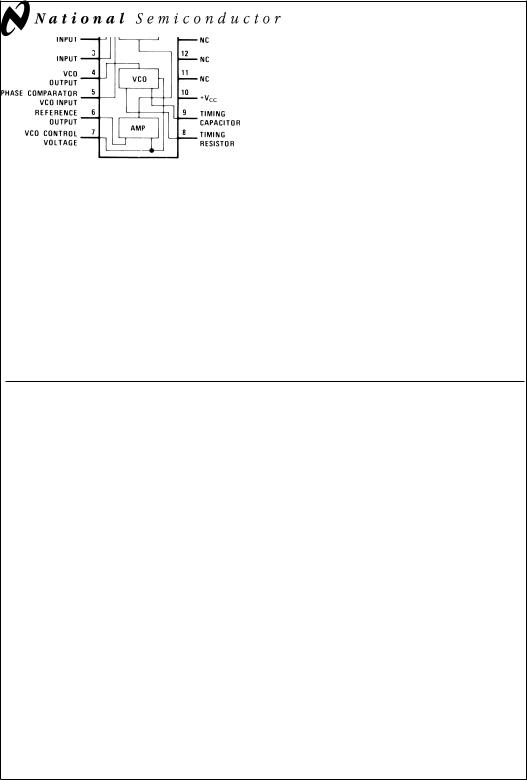
May 1999
LM565/LM565C
Phase Locked Loop
General Description
The LM565 and LM565C are general purpose phase locked loops containing a stable, highly linear voltage controlled oscillator for low distortion FM demodulation, and a double balanced phase detector with good carrier suppression. The VCO frequency is set with an external resistor and capacitor, and a tuning range of 10:1 can be obtained with the same capacitor. The characteristics of the closed loop system Ð bandwidth, response speed, capture and pull in range Ð may be adjusted over a wide range with an external resistor and capacitor. The loop may be broken between the VCO and the phase detector for insertion of a digital frequency divider to obtain frequency multiplication.
The LM565H is specified for operation over the −55ÊC to +125ÊC military temperature range. The LM565CN is specified for operation over the 0ÊC to +70ÊC temperature range.
Features
n200 ppm/ÊC frequency stability of the VCO
nPower supply range of ±5 to ±12 volts with 100 ppm/% typical
n0.2% linearity of demodulated output
nLinear triangle wave with in phase zero crossings available
nTTL and DTL compatible phase detector input and square wave output
nAdjustable hold in range from ±1% to > ±60%
Applications
nData and tape synchronization
nModems
nFSK demodulation
nFM demodulation
nFrequency synthesizer
nTone decoding
nFrequency multiplication and division
nSCA demodulators
nTelemetry receivers
nSignal regeneration
nCoherent demodulators
Connection Diagrams
Metal Can Package |
Dual-in-Line Package |
DS007853-2 |
DS007853-3 |
Order Number LM565H |
Order Number LM565CN |
See NS Package Number H10C |
See NS Package Number N14A |
Loop Locked Phase LM565/LM565C
© 1999 National Semiconductor Corporation |
DS007853 |
www.national.com |

Absolute Maximum Ratings (Note 1)
If Military/Aerospace specified devices are required, please contact the National Semiconductor Sales Office/ Distributors for availability and specifications.
Supply Voltage |
±12V |
Power Dissipation (Note 2) |
1400 mW |
Differential Input Voltage |
±1V |
Operating Temperature Range |
|
LM565H |
−55ÊC to +125ÊC |
LM565CN |
0ÊC to +70ÊC |
Storage Temperature Range |
−65ÊC to +150ÊC |
Lead Temperature |
|
(Soldering, 10 sec.) |
260ÊC |
Electrical Characteristics
AC Test Circuit, TA = 25ÊC, VCC = ±6V
Parameter |
Conditions |
|
LM565 |
|
|
LM565C |
|
Units |
|
|
|
|
|
|
|
|
|||
|
|
Min |
Typ |
Max |
Min |
Typ |
|
Max |
|
|
|
|
|
|
|
|
|
|
|
Power Supply Current |
|
|
8.0 |
12.5 |
|
8.0 |
|
12.5 |
mA |
|
|
|
|
|
|
|
|
|
|
Input Impedance (Pins 2, 3) |
−4V < V2, V3 < 0V |
7 |
10 |
|
|
5 |
|
|
kΩ |
VCO Maximum Operating |
Co = 2.7 pF |
300 |
500 |
|
250 |
500 |
|
|
kHz |
Frequency |
|
|
|
|
|||||
|
|
|
|
|
|
|
|
|
|
|
|
|
|
|
|
|
|
|
|
VCO Free-Running Frequency |
Co = 1.5 nF |
|
|
|
|
|
|
|
|
|
Ro = 20 kΩ |
−10 |
0 |
+10 |
−30 |
0 |
|
+30 |
% |
|
fo = 10 kHz |
|
|
|
|
|
|
|
|
Operating Frequency |
|
|
−100 |
|
|
−200 |
|
|
ppm/ÊC |
Temperature Coefficient |
|
|
|
|
|
|
|||
|
|
|
|
|
|
|
|
|
|
|
|
|
|
|
|
|
|
|
|
Frequency Drift with |
|
|
0.1 |
1.0 |
|
0.2 |
|
1.5 |
%/V |
Supply Voltage |
|
|
|
|
|||||
|
|
|
|
|
|
|
|
|
|
|
|
|
|
|
|
|
|
|
|
Triangle Wave Output Voltage |
|
2 |
2.4 |
3 |
2 |
2.4 |
|
3 |
Vp-p |
Triangle Wave Output Linearity |
|
|
0.2 |
|
|
0.5 |
|
|
% |
|
|
|
|
|
|
|
|
|
|
Square Wave Output Level |
|
4.7 |
5.4 |
|
4.7 |
5.4 |
|
|
Vp-p |
Output Impedance (Pin 4) |
|
|
5 |
|
|
5 |
|
|
kΩ |
|
|
|
|
|
|
|
|
|
|
Square Wave Duty Cycle |
|
45 |
50 |
55 |
40 |
50 |
|
60 |
% |
|
|
|
|
|
|
|
|
|
|
Square Wave Rise Time |
|
|
20 |
|
|
20 |
|
|
ns |
|
|
|
|
|
|
|
|
|
|
Square Wave Fall Time |
|
|
50 |
|
|
50 |
|
|
ns |
|
|
|
|
|
|
|
|
|
|
Output Current Sink (Pin 4) |
|
0.6 |
1 |
|
0.6 |
1 |
|
|
mA |
|
|
|
|
|
|
|
|
|
|
VCO Sensitivity |
fo = 10 kHz |
|
6600 |
|
|
6600 |
|
|
Hz/V |
Demodulated Output Voltage |
±10% Frequency Deviation |
250 |
300 |
400 |
200 |
300 |
|
450 |
mVp-p |
(Pin 7) |
|
|
|||||||
|
|
|
|
|
|
|
|
|
|
|
|
|
|
|
|
|
|
|
|
Total Harmonic Distortion |
±10% Frequency Deviation |
|
0.2 |
0.75 |
|
0.2 |
|
1.5 |
% |
|
|
|
|
|
|
|
|
|
|
Output Impedance (Pin 7) |
|
|
3.5 |
|
|
3.5 |
|
|
kΩ |
|
|
|
|
|
|
|
|
|
|
DC Level (Pin 7) |
|
4.25 |
4.5 |
4.75 |
4.0 |
4.5 |
|
5.0 |
V |
|
|
|
|
|
|
|
|
|
|
Output Offset Voltage |
|
|
30 |
100 |
|
50 |
|
200 |
mV |
|V7 − V 6| |
|
|
|
|
|||||
|
|
|
|
|
|
|
|
|
|
Temperature Drift of |V7 − V 6| |
|
|
500 |
|
|
500 |
|
|
µV/ÊC |
AM Rejection |
|
30 |
40 |
|
|
40 |
|
|
dB |
|
|
|
|
|
|
|
|
|
|
Phase Detector Sensitivity KD |
|
|
0.68 |
|
|
0.68 |
|
|
V/radian |
Note 1: Absolute Maximum Ratings indicate limits beyond which damage to the device may occur. Operating Ratings indicate conditions for which the device is functional, but do not guarantee specific performance limits. Electrical Characteristics state DC and AC electrical specifications under particular test conditions which guarantee specific performance limits. This assumes that the device is within the Operating Ratings. Specifications are not guaranteed for parameters where no limit is given, however, the typical value is a good indication of device performance.
Note 2: The maximum junction temperature of the LM565 and LM565C is +150ÊC. For operation at elevated temperatures, devices in the TO-5 package must be derated based on a thermal resistance of +150ÊC/W junction to ambient or +45ÊC/W junction to case. Thermal resistance of the dual-in-line package is +85ÊC/W.
www.national.com |
2 |
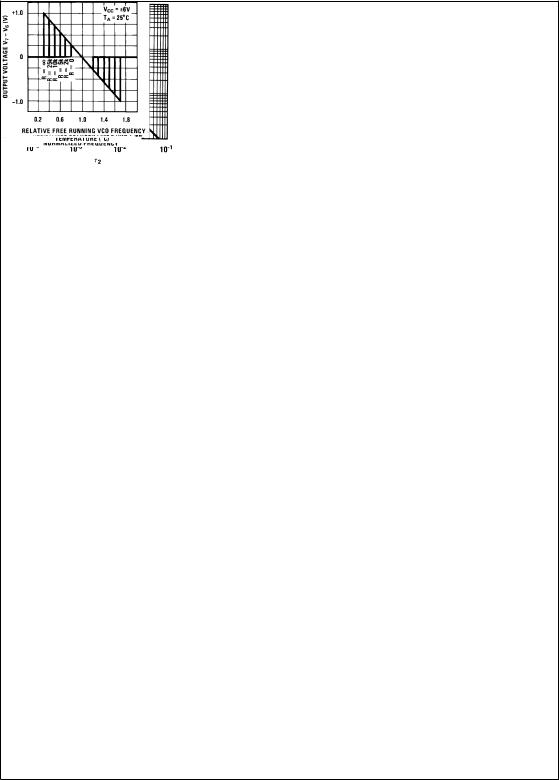
Typical Performance Characteristics
Power Supply Current as a |
Lock Range as a Function |
VCO Frequency |
Function of Supply Voltage |
of Input Voltage |
|
DS007853-16
|
|
DS007853-15 |
|
DS007853-14 |
|
Oscillator Output |
Phase Shift vs Frequency |
VCO Frequency as a |
Waveforms |
|
Function of Temperature |
|
|
|
DS007853-17 |
|
DS007853-18 |
|
DS007853-19 |
Loop Gain vs Load |
Hold in Range as a |
Resistance |
Function of R6±7 |
DS007853-20 |
DS007853-21 |
3 |
www.national.com |

Schematic Diagram
DS007853-1
www.national.com |
4 |
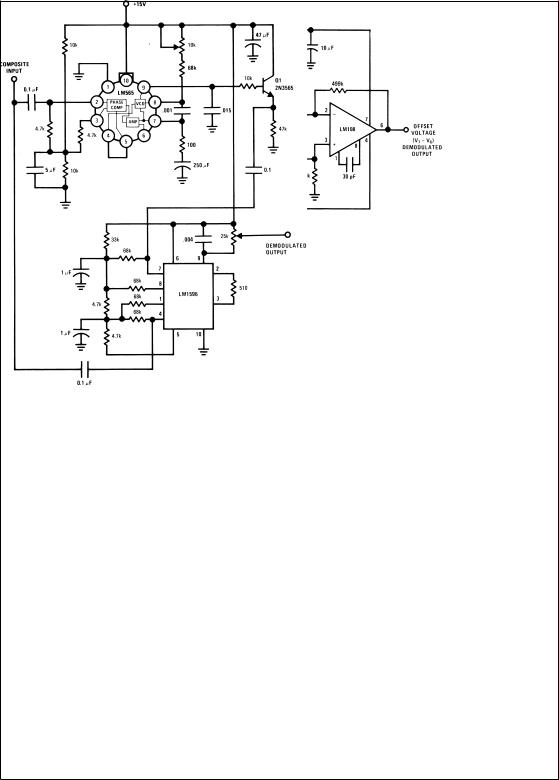
AC Test Circuit
DS007853-5
Note: S1 open for output offset voltage (V7 − V 6) measurement.
Typical Applications
2400 Hz Synchronous AM Demodulator
DS007853-6
5 |
www.national.com |

Typical Applications (Continued)
FSK Demodulator (2025±2225 cps)
DS007853-7
FSK Demodulator with DC Restoration
DS007853-8
www.national.com |
6 |
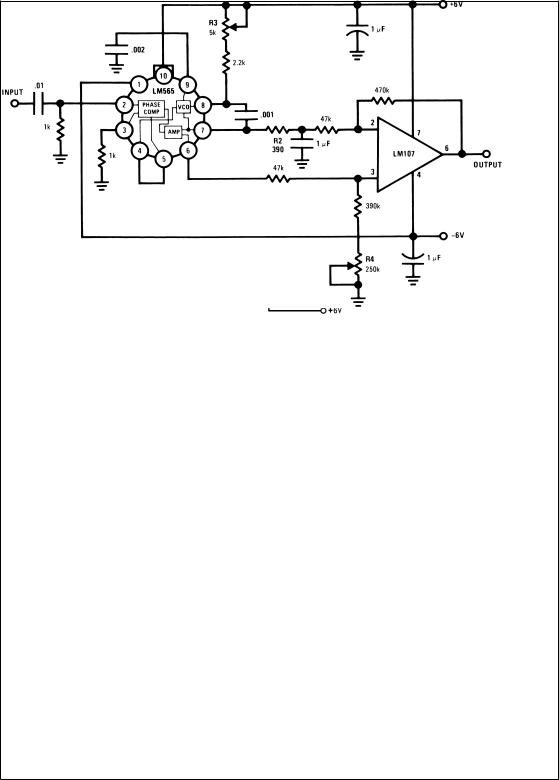
Typical Applications (Continued)
Frequency Multiplier (x10)
DS007853-9
IRIG Channel 13 Demodulator
DS007853-10
7 |
www.national.com |
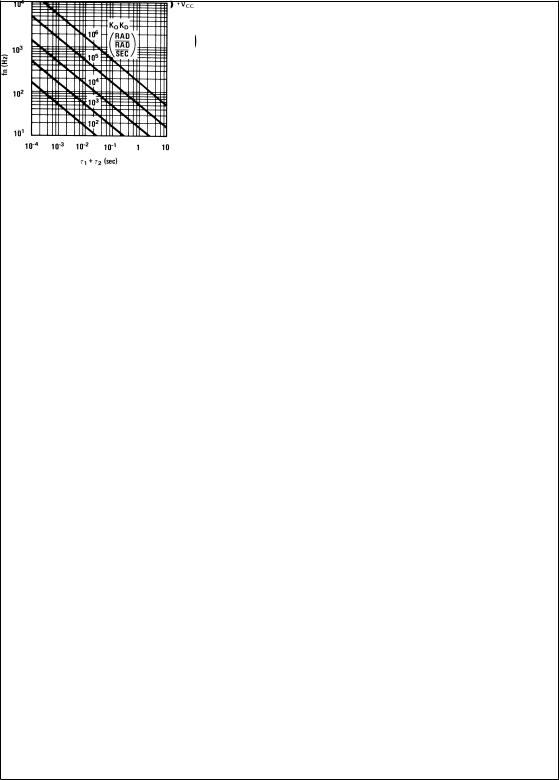
Applications Information
In designing with phase locked loops such as the LM565, the important parameters of interest are:
FREE RUNNING FREQUENCY
LOOP GAIN: relates the amount of phase change between the input signal and the VCO signal for a shift in input signal frequency (assuming the loop remains in lock). In servo theory, this is called the ªvelocity error coefficient.º
Lag-Lead Filter
DS007853-12
A simple lag filter may be used for wide closed loop bandwidth applications such as modulation following where the frequency deviation of the carrier is fairly high (greater than 10%), or where wideband modulating signals must be followed.
The natural bandwidth of the closed loop response may be found from:
The loop gain of the LM565 is dependent on supply voltage, and may be found from:
fo = VCO frequency in Hz
Vc = total supply voltage to circuit
Loop gain may be reduced by connecting a resistor between pins 6 and 7; this reduces the load impedance on the output amplifier and hence the loop gain.
HOLD IN RANGE: the range of frequencies that the loop will remain in lock after initially being locked.
fo= free running frequency of VCO Vc= total supply voltage to the circuit
THE LOOP FILTER
In almost all applications, it will be desirable to filter the signal at the output of the phase detector (pin 7); this filter may take one of two forms:
Simple Lead Filter
Associated with this is a damping factor:
For narrow band applications where a narrow noise bandwidth is desired, such as applications involving tracking a slowly varying carrier, a lead lag filter should be used. In general, if 1/R1C1 < Ko KD, the damping factor for the loop becomes quite small resulting in large overshoot and possible instability in the transient response of the loop. In this case, the natural frequency of the loop may be found from
R2 is selected to produce a desired damping factor δ, usually between 0.5 and 1.0. The damping factor is found from the approximation:
δ ) π τ2fn
These two equations are plotted for convenience.
Filter Time Constant vs Natural Frequency
DS007853-11
DS007853-13
www.national.com |
8 |
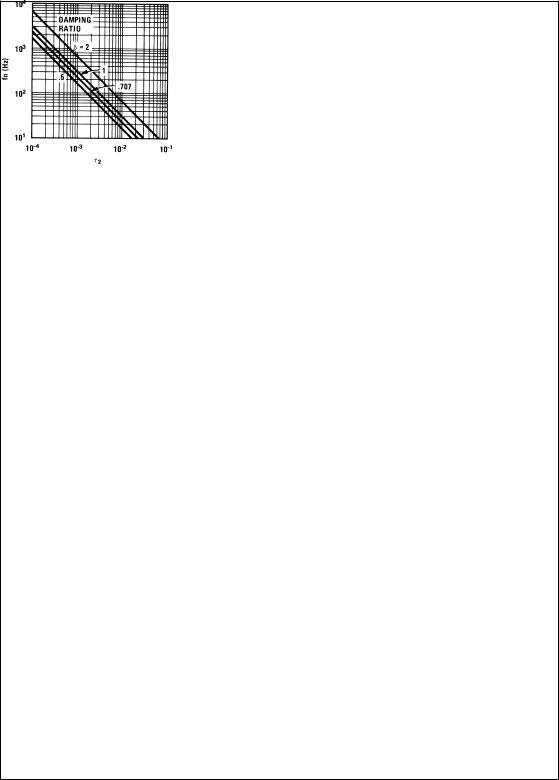
Applications Information (Continued) |
Capacitor C2 should be much smaller than C1 since its func- |
|
tion is to provide filtering of carrier. In general C2 ≤ 0.1 C1. |
Damping Time Constant vs Natural Frequency |
|
DS007853-14
9 |
www.national.com |
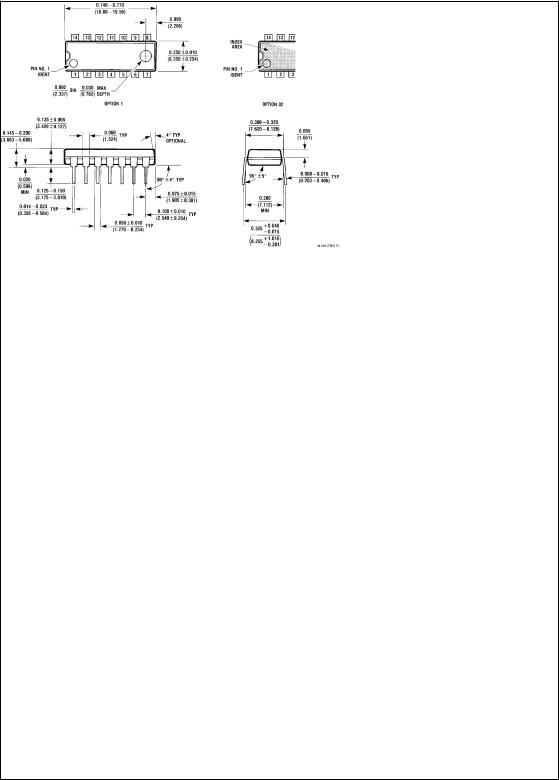
Physical Dimensions inches (millimeters) unless otherwise noted
Metal Can Package (H)
Order Number LM565H
NS Package Number H10C
Dual-In-Line Package (N)
Order Number LM565CN
NS Package Number N14A
www.national.com |
10 |
